Ijraset Journal For Research in Applied Science and Engineering Technology
- Home / Ijraset
- On This Page
- Abstract
- Introduction
- Conclusion
- References
- Copyright
Seismic Behavior of RC Multistorey Building Frame Structure with Different Plan Configuration
Authors: Rajendra Kumar Kichande, Prof. Anubhav Rai
DOI Link: https://doi.org/10.22214/ijraset.2025.66550
Certificate: View Certificate
Abstract
Today’s world facing some of the major problems causing by the nature. One of the major natural disasters is the Earthquake. We never know the Direction of the attack and magnitude of the Earthquake, so it will be the challenge the science and Technology. Past few years’ research done on the various issues of Earthquake. Now a Days people live in Multi-Story Buildings such case when Earthquake knockout the populated areas it will be cause massive loss of Damage. Hence Earthquake analysis get importance to Analysis the structure safe against the collapse and design the structure to safe against earthquake occur during the life time of the structure. In this study model a G+11 Structure with square plan configuration in Staad Pro and Analysis the Earthquake analysis of the Structure in seismic city Jabalpur which is located in seismic region III with Soft, Hard and Medium soil with different seismic and structural parameters are used as per Indian Standard code. The analysis is done by using STAAD Pro V8i software by Linear Static Analysis and compared the analysis of RC multistory building framed structure in the term of Maximum Bending MomentStory wise Displacement.
Introduction
I. INTRODUCTION
The earth Shape is spheroid and it consists of the three layers such as crust, mantle and core. The earthquakes are occurring in the crust layer only, crust layer dived into two parts Lithosphere and asthenosphere. Lithosphere is a rigid plate and it can be dividing into seven major parts and several minor parts. Asthenosphere is a semi rigid part and Lithosphere is float on the Asthenosphere, Because of the convection currents plates of Lithosphere plates are movements takes place, when two plates are hit each other the large amount of energy is released in the form of waves. The waves are hit the earth surface in the form of vibrations that vibrations lead to earthquakes. Tremor vibrations are formed at the point of initiation of rupture to in all directions in the form of elastic waves, these waves are mainly divided into primary waves or p waves, secondary waves or s waves and surface waves. Generally, Earthquakes are formed due to the rupture in the plates, where rupture takes place that is place for origin of the earthquake that place is called as the focus or Hypocenter. The place just above the earth surface is called as the Epicenter. The Distance from focus to Epicenter is known as the focal depth. Earthquake size can be determined by both magnitude and Intensity; magnitude means the amount of Energy is released during the rupture takes place.
Structures are the intricate framework and various things must be thought of. Henceforth at the arranging stage itself, draftsmen and basic specialists must cooperate to guarantee that the negative highlights are kept away from and great structure arrangement is picked. On the off chance that we have a helpless design to begin with, every one of those specialists can do is to give a Band-Aid for example improve an essentially helpless arrangement as most ideal as. Then again, on the off chance that we start off with a decent arrangement and sensible encircling framework, even a helpless architect can't hurt its definitive execution to an extreme. In any case, developments can endure assorted harms when they put under seismic excitations, despite the fact that for same auxiliary setup, area, EQ harms in the frameworks are neither lopsided nor homogenous. A craving to make a stylish and practically productive structure drives engineers to consider awesome and creative structures. Once in a while the state of building grabs the attention of guest, at times the basic framework offers, and in different events both shape and auxiliary framework cooperate to make the structure a Marvel. In any case, every one of these selections of shapes and structure has huge bearing on the presentation of working during solid seismic tremor. So the evenness and normality are typically suggested. The conduct of working during tremor relies fundamentally upon its general shape, size and geometry. Structures with sporadic geometry react distinctively against seismic activity. Plan geometry is the boundary which chooses its presentation against various stacking conditions. The impacts of inconsistency (plan and shape) on structure have been done by utilizing auxiliary examination programming STAAD Pro. V8i. Tremors, brought about by developments on the earth surface, bring about various degrees of ground shaking prompting harm and breakdown of structures and common infra-structures.
The structure ought to withstand moderate degree of seismic tremor ground movement without auxiliary harm, however perhaps with some basic just as nonstructural harm. This breaking point state may compare to tremor power equivalent to the most grounded either experienced or figure at the site.
A. Building Plan
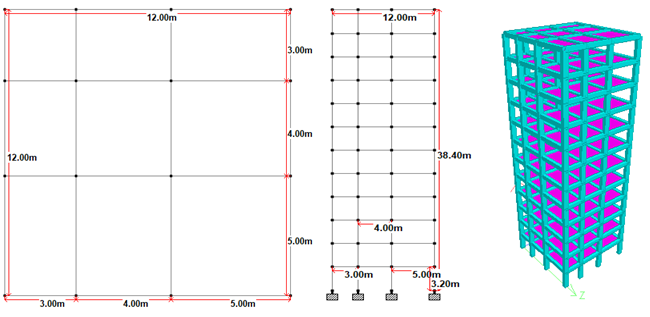
In this research work the Building Plan configuration taken as Rectangular in shape with G+11, each floor height 3.5m. Building is locating in seismic zone III with Soft, Medium & Hard soil.
B. Objective of Research
- To know the seismic behaviors on RC building due to Earthquake Forces.
- Comparative Seismic Analysis of Structure between different types of Soil.
- To analyses the G+11 RC building by Linear Static Method by using Staad Pro
II. LITRATURE REVIEW
- Amit Chakrawarty, Sourav Ray etc all {P8}[2016] – He examined four distinctive formed (W-shape, L-shape, Rectangle, Square) ten celebrated RCC building outlines are investigated utilizing ETABS v9.7.1 and SAP 2000 v14.0.0 for seismic zone 3 (Sylhet) in Bangladesh. Similar examination on the greatest removal of various formed structures because of static stacking and dynamic reaction range has been investigated. From the broke down outcomes it has been discovered that, for static burden investigation, impacts of quake power around same to all models with the exception of model-1(W-shape).W-shape has been discovered generally defenseless for seismic tremor load case. It is additionally found from the reaction range investigation that the removals for sporadic formed structure outlines are more than that of standard molded structure.
- Gauri G. Kakpure, Ashok R. Mundhada {P9}[2016] – He inspected G+15 story-high structure of four very surprising shapes like Rectangular, L-shape, H-shape, and C-shape were utilized for correlation. The total models were investigated with the help of ETABS 9.7.1 rendition. Relative Dynamic Analysis for each of the four cases had been done to assess the misshapening of the structure. Working with extreme anomaly delivers more disfigurement than those with less inconsistency especially in high seismic zones. What's more, conjointly the story toppling second changes conversely with stature of the story. The story base shear for normal structure is most elevated contrasted with sporadic molded structures. Story float allowed is 0.004.times the stature of story. A Story float increment with increment in tallness of the story up to seventh story coming to most extreme worth and afterward it again begins diminishing. The most extreme story float allowed is 0.004 x tallness of story. The distinction of estimations of dislodging among static and dynamic investigation is immaterial for lower stories however the thing that matters is expanded in higher stories and static examination gives higher qualities than dynamic investigation. Static examination isn't adequate for tall structures and it's important to give dynamic investigation. Working with re-contestant corners experienced increasingly horizontal float and decrease in base shear limit contrasted with normal structure. When contrasted with unpredictable design the story float esteem is more in the ordinary setup. Story float is expanded as stature of building expanded. The sporadic shape building experiences more twisting and subsequently normal shape building must be liked. The consequences of proportionate static examination are around uneconomical on the grounds that estimations of dislodging are higher than dynamic investigation.
- Ashish Sadh, Ankit Pal {P10}[2018] – He reviewed the conduct of tall structure against the breeze power in wind zone second, L shape is read and broke down for explicit heights. Also bearing of wind assumes crucial job in conduct of structure. On playing out the broad overview of the writing accessible n building structure it very well may be reasoned that because of a wide assortment of structures, the inside and out comprehension in the field of wind Analysis and plan of building structures is insufficient. The IS codes has given certain rule based on which the structure structures can be planned when exposed to wind loads. The writing review in the exhibition and conduct of building structures when exposed to wind loads recommends that the prerequisite of setting up a technique for contemplating the reaction of building structure to gasping for air loads has gotten basic. Numerous specialists have performed work over different kinds of building. On the various kinds of structures and discover the significant boundary which is helpful for understanding the conduct of wind powers.
- Mr. Ankit Sonkar and Ms. Srishti Verma (2023): - They analysis of high rise building (G+10) storey with & without shear walls. They also involved the correlation between framed & framed with shear wall building in presence wind force, earthquake force, etc for seismic design of buildings, reinforcement concrete structural walls or shear walls are higher earthquake resisting members which abstain from lateral load resistance and building is in the Zone IV with loose soil is conferred and analysis is done by using STADD-pro Software by seismic analysis & wind effect. They observed that the displacement & bending moment at z direction, shear force at y-direction& axial force at x-direction is found & compared to the shear wall & without shear wall models.
III. MATHEDOLOGY
In This research work deals with relative study of earthquake behavior on RC building structures G+11 of different soil conditions and this building frame structure of Square Shape with three soil condition for Jabalpur, Madhya Pradesh under the Earthquake effect as per IS 1893(part I) -2016 static analysis. Comparative Analysis is done in the term of Max. Bending moment, Max. Storey Displacement, has been carried out.
In this work included various steps:
- Step-1 Modeling of building frame in structure wizard with different type of soils of G+11 in square shape.
- Step-2 Creating 3D frame structure.
- Step-3 Providing seismic zone and soil conditions as per IS-1893 (Part-I):2016
- Step-4 Applied various type load and load combination.
- Step-5 Analysis of building frames Structure, providing different seismic zones.
- Step-6 After analysis the structure compared all the results of Max. B.M., SF. Deflection, displacement, storey displacement etc.
IV. MATHEDOLOGY
STAAD. Pro is a general-purpose program for doing the analysis the structure with different types soil condition and seismic region Jabalpur, Madhya Pradesh which is located in earthquake region III. The following three activities must be performed to achieve that goal. (a) Model generation using STAAD.Pro. (b) The calculations to determine the analytical results. (c) Result check is all encouraged by apparatuses contained in the system's graphical surroundings.
- Parameter Using: Type of Building: Reinforced Concrete Framed Structure-Plan Configuration- Square- Shape, Number of Floor: G+11, Size of Column = 450mm x 700mm, Beam = 450mm x 600mm Height of each floor = 3.2m, Thickness of Slab= 150mm, Thickness of Masonry Wall= 230 mm, Density of RCC: 25 KN/m3, Density of Masonry: 20.0 KN/m3.
- Seismic Parameter: As per IS 1893-2002: Seismic Zone- III, Type of soil- Soft Soil, Medium and Hard Soil, Damping = 5% (as per table-3 clause 6.4.2), Zone factor for zone III, Z=0.16) Importance Factor I=1.5 (Important structure as per Table-6) Response Reduction Factor R=5 for Special RC moment resisting frame (Table-7) Sa/g= Average acceleration coefficient (depend on Natural fundamental period)
- Dead Load: wall load 12.65 KN/m , parapet wall 4.6 KN/m, slab 3.75 KN/m2, finish load 1 KN/m2, total 4.75 KN/m2,
- Live Loads: as per IS: 875 (Part-2) 1987 :Live Load on typical floors = 3.0kN/m2, Live Load seismic calculation = 0.75kN/m2. )
- Earth Quake Loads: All frames are analyzed for the earthquake zones III. The seismic load calculation are as per IS: 1893 (2016).
V. RESULT ANALYSIS
A. Storey Wise Displacement (mm) in X and Z direction
Table 5.1.1: Displacement in X and Z direction
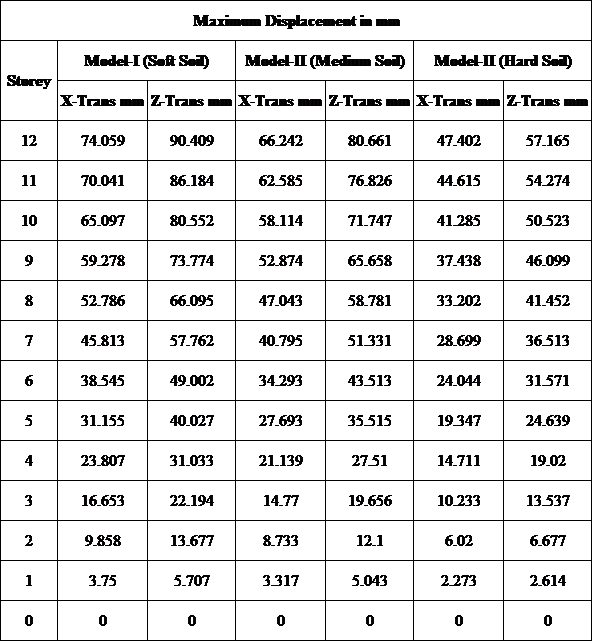
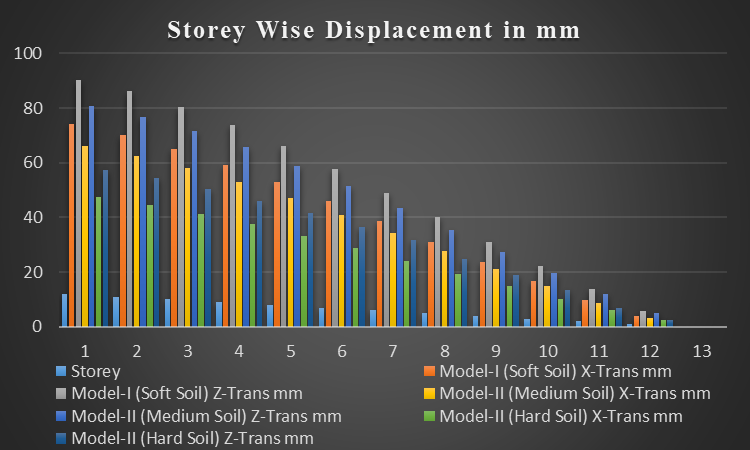
???????B. Axial Force in KN
Table 5.1.3.: Axial force
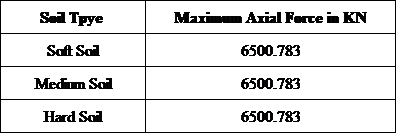
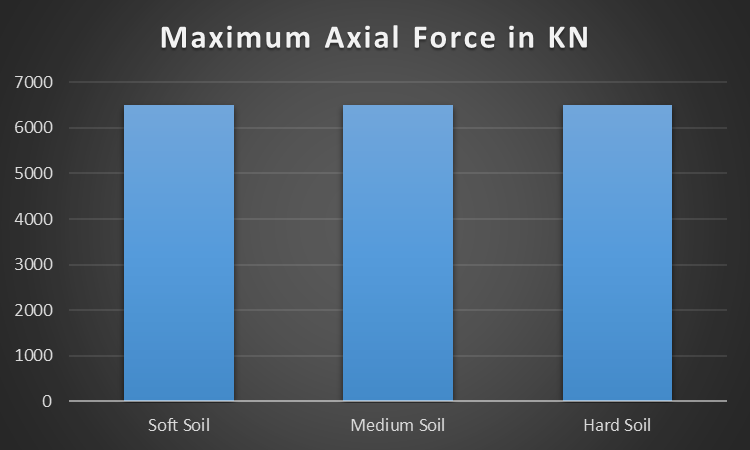 ???????
???????
Conclusion
A. Storey Displacement 1) As per analysis, found that the maximum storey displacement is 74.059 mm in soft soil and minimum 47.402 mm in hard soil condition along the X direction. 2) It is seen that the maximum storey displacement 90.409 mm in soft soil and minimum 57.165 mm in hard soil condition along the Z direction. 3) While comparing as percentage, the displacement 39.74 % (medium) and 56.24 % (soft) more displacement as compared to hard soil along the X direction. 4) Similarly, the displacement 41.10 % (medium) and 58.15 % (soft) more displacement as compared to hard soil along the Z direction. 5) Overall, we found that the maximum storey displacement in soft soil conditions and minimum storey displacement in hard soil condition along the X and Z direction. It means that the hard soil condition is much better than the soft soil for high rise and tall structure. 6) It is also observed that the storey displacement at base is zero for all the case along the X and Z direction and storey displacement is increased with the increased the number of storied. It means that if the number of storied or height of storied increased then leteral forces are also increased and ultimately storey displacement is increased in the structures. B. Axial Force 1) It is observed that the maximum axial force is 6500.783 KN in the soft soil, medium and hard soil condition that means the axial forces are same for all the cases. 2) The variation in the axial forces in the structure that means Buildings in seismic zones are often designed to withstand lateral loads, such as earthquakes, which can induce axial forces. If the lateral loads are evenly distributed or balanced throughout the structure, the resulting axial forces may also be similar.
References
[1] Prof. S.S. Patil, Miss. S.A. Ghadge, Prof. C.G. Konapure, Prof. C.G. Konapure(2013) “Seismic Analysis of High-Rise Building by Response Spectrum Method” International Journal Of Computational Engineering Research (Ijceronline.Com) Vol. 3 Issue. 3 [2] E. Pavan Kumar, A. Naresh, M. Nagajyothi, M. Rajasekhar(2014) “ Earthquake Analysis of Multi Storied Residential Building - A Case Study” International Journal of Engineering Research and Applications ISSN. [3] Neha P. Modakwar, Sangita S. Meshram, Dinesh W. Gawatre(2014) “Seismic Analysis of Structures with Irregularities” IOSR Journal of Mechanical and Civil Engineering (IOSR-JMCE). [4] Pralobh S. Gaikwad, Prof. Kanhaiya K. Tolani(2015) “Study Of Dynamic Effect On Unsymmetrical Building (Rcc & Steel)” IJREAT International Journal of Research in Engineering & Advanced Technology. [3] Mahesh N. Patil, Yogesh N. Sonawane(2015) “Seismic Analysis of Multistoried Building” International Journal of Engineering and Innovative Technology (IJEIT)R. E. Sorace, V. S. Reinhardt, and S. A. Vaughn, “High-speed digital-to-RF converter,” U.S. Patent 5 668 842, Sept. 16, 1997. [5] Asokan J.J. (2006) “Introduction to Structural Motion Control. New York”, “International Journal of Innovative Research in Science, Engineering and Technology” (An ISO 3297: 2007 Certified Organization) Vol. 2, Issue 12, pp 35-42. [6] Raju P.S.N, Reddy S.R.K, Raju K.R.K,(2004): Influence of soil-structure interaction on response of structures against earthquake forces. STTp on disaster resistant design and construction of structures. [7] Bureau Of Indian Standards Is 1893 (Part I): 2002. Criteria For Earthquake Resistant Design Of Structures. Part I General Provisions And Buildings, 2002.. [8] IS 13920 (1993)”Ductile detailing of reinforces concrete structures subjected to earthquake forces” [9] IS 456:2002“Plain and Reinforced Concrete-Code of practice” [10] Finite Element Analysis Of Frame With Soil Structure Interaction By Gaikwad M.V1, Ghogare R.B2 , Vageesha S. Mathada3 Soil Structure Interaction In The Analysis And Seismic Design Of Reinforced Concrete Frame Buildings Julio A. García 1
Copyright
Copyright © 2025 Rajendra Kumar Kichande, Prof. Anubhav Rai. This is an open access article distributed under the Creative Commons Attribution License, which permits unrestricted use, distribution, and reproduction in any medium, provided the original work is properly cited.

Download Paper
Paper Id : IJRASET66550
Publish Date : 2025-01-17
ISSN : 2321-9653
Publisher Name : IJRASET
DOI Link : Click Here
 Submit Paper Online
Submit Paper Online

